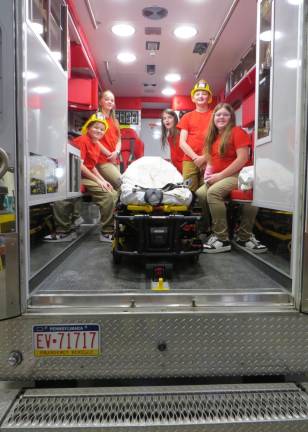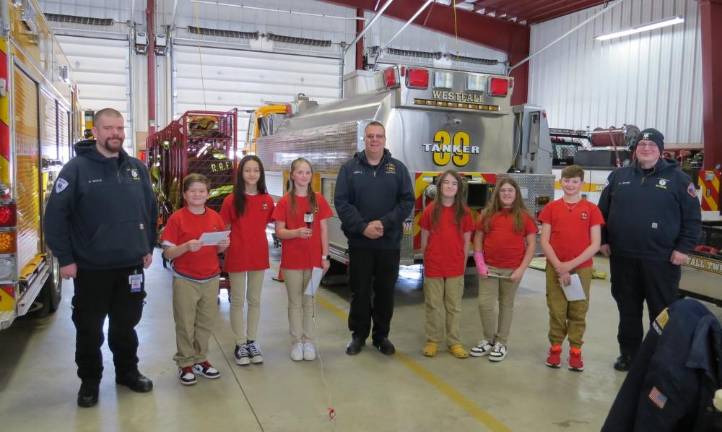DVE reporters interview Westfall firefighter
Westfall. These young journalists asked Assistant Fire Chief Kyle Innella some tough questions!


Delaware Valley Elementary News/TV reporters recently spent a day at the Westfall Firehouse where they had the opportunity to interview Assistant Fire Chief Kyle Innella.
At Firehouse 39 for three years, Innella retired from doing 30 years as a firefighter at West Point. Innella’s interest in firefighting began at age 5 when, his dad, also a firefighter, would bring him to the firehouse. When he became a firefighter in 1988, the first person he told was his father.
While Innella’s first fire call was to a brush fire, he said the most difficult lifesaving situation is when children are involved and added that he has saved multiple people in his career. When asked how he handles distressed pets in a fire, he said he is sure to bring them immediately to their family after being rescued. His favorite part of being a firefighter is saving people.
When asked how they handle fires in the many developments in our area without fire hydrants, he said they use tanker trucks. When they receive the distress call and are given the address, they know whether there are hydrants in the area and prepare as needed. They get their water for their tanker trucks from fire hydrants, rivers, lakes and ponds. A small tanker truck can hold 250 gallons of water and the larger one carries 2,000 gallons of water. The tanker truck can pump water out of the truck in between two and 15 minutes before it runs out of water.
Innella has worked on hundreds of fires in his career and so far, this year, Westfall Firehouse has put out approximately 35 fires. All the firefighters in Westfall are volunteers, except for the EMTs. Due to the EMT shortage, Westfall pays them.
Assistant Fire Chief Innella said he enjoys driving fire trucks, except when drivers do not move out of the way. He explained that firefighters are not required to have a special license to drive a fire truck, but they do require special training. He told us that driving a firetruck is not the same as driving a car. It’s a lot heavier and a lot more responsibility sharing the road with other cars and making sure those inside the truck are safe as well.
We asked how they know when there’s an emergency and Innella said that their pager or phone goes off, or they can hear through the speakers in the firehouse.
How is being a fire chief different than being a firefighter? Well, he said there is much more responsibility in directing the firefighters to keep them safe.
The number of trucks they bring to an emergency depends on the emergency. A brush fire or downed wire would require the brush truck. We learned the difference between a ladder truck and a fire engine. The fire engine carries the water. The ladder truck does search and rescue.
Innella said it feels good to fight fires, but as you get older the equipment is more cumbersome. As you get ready for a fire call, the adrenaline really picks up and as the emergency is taken care of the adrenaline drops and you can get very tired.
We learned that a fire truck can go 10 miles over the limit and yes, they can get a speeding ticket if they go too fast. The last thing they would want to do is create an accident. It usually takes them up to 90 seconds to put on their gear, however scuba gear for search and rescue can take five minutes to get on.
As part of our trip, we were allowed to go inside an ambulance, fire engine and a special unit trailer.
We would like to thank Westfall Assistant Fire Chief Kyle Innella and EMTs Matthew Moore and Sean Boyle for a wonderfully informative visit!